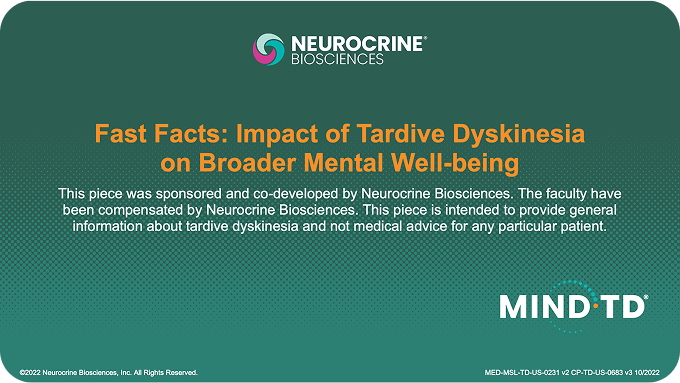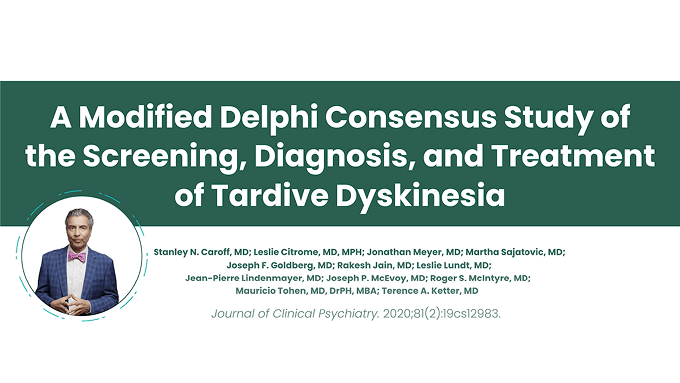This is a hypothetical patient case developed for educational purposes by Michelle Shamblin, RN, APMHNP-BC, CARN-AP, based on characteristics of patients with tardive dyskinesia as seen in clinical practice. The hypothetical case was sponsored and co-developed by Neurocrine Biosciences.
Brianna P. is a 31-year-old African American woman being treated for schizophrenia and generalized anxiety disorder (GAD). At a recent check-in with her licensed clinical social worker (LCSW), she stated that she was worried people were watching her more closely because of the involuntary lip smacking movements and sounds she has been making.
Brianna was at a regular check-in with her LCSW when she claimed that strangers have been staring at her. She states that she has been making lip smacking sounds and thinks it’s related to dry mouth. She is worried that people think she is making lewd gestures. Having attended a recent presentation on the treatment challenges in schizophrenia, the LCSW knows that abnormal mouth movements like this can be one of many signs of TD. Given Brianna’s history of antipsychotic medication use, the LCSW made a note in her medical records and reached out to her psychiatric NP directly, who sets up an appointment for Brianna to be seen later that week.
Patient Information
- Name: Brianna P.
- Age: 31 y
- Sex: Female
- Race/Ethnicity: African American
- BMI: 29
- BP: 145/100 mm Hg
- Current problems:
- Schizophrenia
- GAD
- Abnormal lip smacking
- Gastrointestinal infection with vomiting
- Current medications:
- Ziprasidone 80 mg PO BID, with 500 kcals of food
- Buspirone 15 mg BID
- Promethazine 25 mg 3-4 times daily for 3 days
BID, twice daily; BMI, body mass index; BP, blood pressure; NP, nurse practitioner; PO, by mouth.
Brianna was diagnosed with schizophrenia in her mid-teens and has been treated with atypical antipsychotics for 15 years. She is currently taking ziprasidone and her hallucinations and delusions are under control. Based on her history and current presentation, the goals of the visit with her psychiatric NP are to maintain control of her psychiatric symptoms and address the abnormal lip movements.
Psychiatric History
- Current diagnosis: Schizophrenia, GAD
- Previous psychiatric diagnoses: None reported
- Current psychiatric medication: Ziprasidone 80 mg and buspirone 15 mg
- Psychiatric medication history: Haloperidol decanoate IM, olanzapine, aripiprazole
- Safety concerns: None reported
- Previous psychiatric hospitalizations: 2 due to mental illness relapse
Substance use: None reported
IM, intramuscular.
The psychiatric NP reviews Brianna’s medical history and notices that she was recently treated for nausea and vomiting associated with a gastrointestinal infection. The NP also notices in the medical record that about 10 years ago, Brianna experienced akathisia and tremors after starting on aripiprazole and discontinued treatment after 3 weeks. After switching to ziprasidone, Brianna has not experienced any abnormal movements until just recently. Brianna thought the lip smacking might be due to dry mouth, but on examination, her mucosal membranes were moist and Brianna denied any symptoms of thirst. The NP decides to conduct a motor evaluation.
History of Movement Disorders
- History of akathisia and tremors 10 years ago when she was taking aripiprazole
- Aripiprazole was discontinued after 3 weeks
- No abnormal movements on ziprasidone until recently
The psychiatric NP ensures that there was no gum or candy in Brianna’s mouth and verifies that her teeth are not bothering her. She then conducts an exam using the AIMS scale, which reveals a TD score of 3. The NP also notes an absence of muscle rigidity and that Brianna’s gait is normal with a normal arm swing. There is no evidence of a parkinsonian tremor. A diagnosis of TD is made, consistent with Brianna’s long-term use of antipsychotics. The psychiatric NP recalls that antipsychotic dose reduction can sometimes temporarily worsen or reveal TD.1 She consults with the attending psychiatric physician and confirms her suspicion that the TD movements may have been exacerbated or revealed by the recent vomiting, which may have effectively caused an abrupt decrease in her ziprasidone levels given that absorption of the drug requires consumption with 500 kcals of food.2
Motor Evaluation
- Abnormal oral movements
- Lip smacking movements with sounds
- No muscle rigidity noted
- Normal gait with normal arm swing
- No tremor observed
- AIMS exam:
AIMS, Abnormal Involuntary Movement Scale.
Brianna’s psychiatric NP provides her with education about TD and the available treatments. They set up an appointment for Brianna to return in a month, allowing enough time for the promethazine to completely clear from her system, fully recover from the gastrointestinal infection, and reliably take ziprasidone with food. At that time, they will determine the best course of treatment for the TD symptoms. The NP tells Brianna to contact her sooner if the severity and types of involuntary movements increase.
Notes From Today's Visit
- Patient provided with education on TD and the risk for additional symptoms
- Scheduled an appointment in 1 month to discuss treatment options
References
1. Ward K, Citrome L. Neurol Ther. 2018;7(2):233-248.
2. Gandelman K, et al. J Clin Psych. 2009;70(1):58-62.








